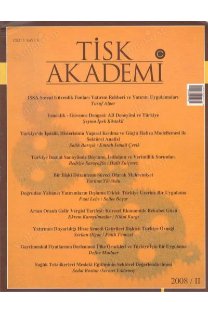AB’nde Güvenceli Esneklik ve Türkiye’deki Yasal Düzenlemeler
Flexicurity in EU and Legal Arrangements in Turkey
___
- Alpagut, G. (2006), Karar İncelemesi, LEGAL İHSGHD, S. 10, 2006.
- Alpagut, G. (1998), Belirli Süreli Hizmet Sözleşmesi, İstanbul.
- Alpagut, G. (2005), “İş Sözleşmesinin Feshi ve İş Güvencesi, İki Yıllık Uygulamanın Ardından İş Sözleşmesinin Feshi ve İş Güvencesi Sistemine Genel Bakış”, III. Yılında İş Yasası, 21-25 Eylül 2005, Bodrum.
- Alpagut, G. (2005), “Mesleki Anlamda Geçici İş İlişkisi: Sınırlamadan Teşvike”, A. Can Tuncay’a Armağan, İstanbul.
- Alpagut, G. (2006), “AB’de İstihdam Politikaları, Esneklik Arayışları ve Türkiye’deki Yasal Düzenlemeler”, İşveren D. Özel Eki, Eylül 2006.
- Alpagut, G. (2006), “İş Sözleşmesinin Feshinde Sosyal Seçim Yükümlülüğü Mevcut mudur?” Sicil D., Aralık 2006, S.4.
- TİSK Yayını (2006), “Avrupa İstihdam Stratejisi ve İşgücü Piyasası Gelişmeleri”
- Barbier, J.C. (2005), “Learning from Denmark? Reşections on the ‘Danish Miracle’ from a French Angle”, EPC Working Paper No. 20, The Nordic Model: A recipe for European Success.
- Bonin, H. (2004), “Lockerung des Kündigungsschutzes, Ein Weg zu Mehr Bechaeftigung?”, Forschungsinstitut zur Zukunft der Arbeit Institute for the Study of Labor, Bonn.
- Bredgard, T.; Larsen, F.; Madsen, P.K. (2005), The Şexible Danish Labour Market A Review, Carma Aaalborg University.
- Çankaya, O.G.; Günay, C.İ.; Göktaş S. (2005), Türk İş Hukukunda İşe İade Davaları, Ankara.
- “Flexicurity Pathways”, Expert Group on Flexicurity, Interim Report From Rapporteur, Presented at the Stakeholder Conference on Flexicurity (April 20 th., 2007), Brussels.
- Flexicurity: The Response to Globalisation and Demographics by Combining Flexibility and Security.
- http://ec.europa. eu/employment_social/ employment_strategy/şexmeaning en.htm
- Grünbuch, Ein Moderneres Arbeitsrecht für die Herausforderungen des 21. Jahrhunderts (2006), Brüssel.
- “Hintergrunddokument, Stakeholder Konferenz zum Thema Şexicurity” (2007), Brüssel, Europaische Kommission. Hromadka, W.; Maschmann, F. (2005),
- “Arbeitsrecht” Band I, Individualarbeitsrecht, 3. Auşage.
- “Today and Tomorrow”, Employment and Social Affairs, European Employment Strategy. http:// ev. europa. Eu/employ- m e n t _ s o c i a l / e m p l o y m e n t _ s t r a tegy/eestm_en.htm
- “The Response to Globalisation and Demographics by Combining Şexibility and Security”, Employment and Social Affairs, European Employment Strategy. http://ec.Europa.eu /employment_social /employment_ strategy/şex_meaning_en. htm.
- Jahn, E.J. (2002), “Brauchen Wir Einen Allgemeinen Kündigungsschutsz?”, Friedrich Alexander-Universitaet, Erlangen- Nürnberg, Diskussionspapiere, No.9, Februar 2002.
- Koene, B.; Paauwe J.; Groenewegen, J. (2004), “Understanding the Development of Temprorary Agency Work in Europe” ERIM (Erasmus Research Institute of Management Report Series), October 2004.
- Nectoux, F.; Maesen L van der, “From Unemployment to Şexicurity-Opportunities and Issues for Social Quality in the World of Work in Europe”, European Journal of Social Quality, Vol.4, 1/2.
- Rebhahn, R. (2003), “Der Kündigungsschutz des Arbeitnehmers in den Staaten der EU”, ZfA
- Schiek, D. (2004), “Agency Work-from Marginalisation towards Acceptance? Agency Work in EU Social and Employment Policy and the “Implementation” of the Draft Directive on Agency Work into German Law”, German Law Journal, Vol.05,No.10.
- Tuncay, C. (2003), “İş Kanunu Tasarısındaki Ödünç İş İlişkisi ve Eleştirisi”, Mercek, Nisan, 2003.
- Weyand, F.; Duewell, F.J. (2005), “Das Neue Arbeitsrecht”, Hartz Gesetze und Agenda 2010 in der Arbeits und Sozialrechtlichen Praxis, Baden-Baden .
- Wilthagen, T.; Velzen, M.V (2004), “The Road Towards Adaptability, Şexibilty and Security”. http:/www. Peerreview-employment. org.
- ISSN: 1306-6757
- Yayın Aralığı: 2
- Başlangıç: 2006
- Yayıncı: Türkiye Isveren Sendikalari Konfederasyonu
Özel Emeklilik Sistemleinde Cinsiyete Dayalı Gelir Farkı: Türkiye Örneği
Muhsin KAR, Adem Yavuz ELVEREN
AB’nde Güvenceli Esneklik ve Türkiye’deki Yasal Düzenlemeler
Hedge Fonlar: Eğilimler ve Riskler
İş Sağlığı ve Güvenliğinde İşverenin Cazai Sorumluluğu
Türkiye'de Enflasyon-Ekonomik Büyüme İlişkisi: Sınır Testi Yaklaşımı
